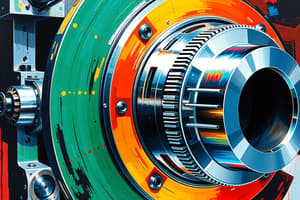Podcast
Questions and Answers
What is the primary purpose of machining in manufacturing?
What is the primary purpose of machining in manufacturing?
- To decrease the surface finish of the workpiece
- To remove unwanted material from a workpiece to obtain the required shape and size (correct)
- To increase the weight of the workpiece
- To change the material properties of the workpiece
What is a critical aspect of machining precision components?
What is a critical aspect of machining precision components?
- High material removal rate
- Close tolerance values (correct)
- Rough surface finish
- Low dimensional accuracy
What is a key characteristic of a cutting tool?
What is a key characteristic of a cutting tool?
- Softer than the workpiece
- Variable hardness
- Same hardness as the workpiece
- Harder than the workpiece (correct)
Which machine tool is commonly used for turning and shaping cylindrical workpieces?
Which machine tool is commonly used for turning and shaping cylindrical workpieces?
What is a desirable surface finish attribute in machining?
What is a desirable surface finish attribute in machining?
What is the term for the process of removing unwanted material from a workpiece?
What is the term for the process of removing unwanted material from a workpiece?
What is the primary objective of manufacturing?
What is the primary objective of manufacturing?
What is the primary focus of precision manufacturing?
What is the primary focus of precision manufacturing?
What is the role of cutting tools in machining operations?
What is the role of cutting tools in machining operations?
What is the significance of tool angles in machining operations?
What is the significance of tool angles in machining operations?
What is the primary goal of machining operations in manufacturing?
What is the primary goal of machining operations in manufacturing?
What is the primary factor in determining the surface finish requirements of a workpiece?
What is the primary factor in determining the surface finish requirements of a workpiece?
What is the angle between the tool face and a line perpendicular to the new workpiece surface?
What is the angle between the tool face and a line perpendicular to the new workpiece surface?
Which of the following materials typically requires a rake angle of 30° for high-speed steel cutting tools?
Which of the following materials typically requires a rake angle of 30° for high-speed steel cutting tools?
What is the purpose of the clearance angle in machining operations?
What is the purpose of the clearance angle in machining operations?
Which of the following is an advantage of a positive rake angle?
Which of the following is an advantage of a positive rake angle?
What is the relationship between the rake angle, clearance angle, and wedge angle?
What is the relationship between the rake angle, clearance angle, and wedge angle?
What is the term for the depth of the individual layers removed by the tool?
What is the term for the depth of the individual layers removed by the tool?
Flashcards are hidden until you start studying




